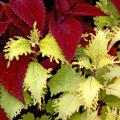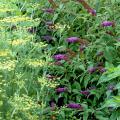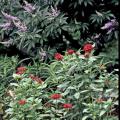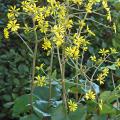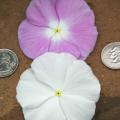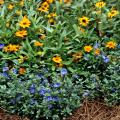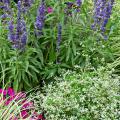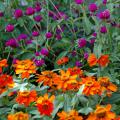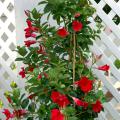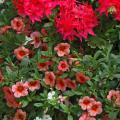Southern Gardening from 2008
By Norman Winter
MSU Horticulturist
Central Mississippi Research & Extension Center
As we enter the New Year, most of us have planted everything we are going to plant until spring, making this a time for reflecting on how things went the past growing season and to plan for next year's flower border.
Last summer, we were filming our Southern Gardening TV news segment at a site with beautiful bedding plants. If I made a poster of the photo I took and put a title on the picture, it would be something like “Adjectives and Accolades.”
By Norman Winter
MSU Horticulturist
Central Mississippi Research & Extension Center
As you contemplate what plants to try when winter has finally run its course, let me recommend using a lot of colorful foliage. There are amazing choices available today in both leaf color and texture.
In our Mississippi State University trials last year, two coleuses attracted quite a bit of attention. Both were planted in full sun, but they would do equally well in filtered light.
By Norman Winter
MSU Horticulturist
Central Mississippi Research & Extension Center
More and more homeowners are sticking herbs or vegetables in their flower borders so they can snip a few leaves or flowers for culinary purposes. With that in mind, I've got another plant for everyone to consider.
By Norman Winter
MSU Horticulturist
Central Mississippi Research & Extension Center
The Mexican petunia, or ruellia, is getting more popular with each growing season, and I give a hearty “amen.” One thing that surprised me is how it has crossed from home to commercial landscapes. Most of the time, commercial landscape plants create a frenzy with homeowners.
As you pace the aisles of your garden center this spring, wondering what to plant for color and what to choose as a partner, think about the iridescent blue from the Mexican petunia.
By Norman Winter
MSU Horticulturist
Central Mississippi Research & Extension Center
When spring arrives and gardeners start trying to jazz up the landscape with color, many will look for long-lasting color so they won't have to change out plant material a couple of times before fall. If that is your goal, too, I would like to heartily recommend the Astoria and Intensia series of phlox.
By Norman Winter
MSU Horticulturist
Central Mississippi Research & Extension Center
The lilac chaste tree, or vitex, was chosen as a Mississippi Medallion award winner in 2002, spurring a revival of this great, old-fashioned plant, which some consider a small tree and others describe as a large shrub.
Known botanically as Vitex agnus-castus, the lilac chaste tree is a marvel with its small structure and large, marijuana-looking leaves. Its fragrant, blue blooms are rare among trees.
By Norman Winter
MSU Horticulturist
Central Mississippi Research & Extension Center
If you are looking to add some character to your shade garden, then you must add the leopard plant to your mix. This terrific plant is still mostly unknown to gardeners, but new varieties are popping up that are simply irresistible.
By Norman Winter
MSU Horticulturist
Central Mississippi Research & Extension Center
Few people recognize the plant name tradescantia, but most people are familiar with spiderwort, Purple Heart, Wandering Jew, Moses-in-the-cradle, Three-men-in-the-boat and Moses-in-the-bulrushes, which are all tradescantia. Now add Sweet Kate to the list of must-have tradescantias.
By Norman Winter
MSU Horticulturist
Central Mississippi Research & Extension Center
Container gardening has exploded in popularity with about 47 percent of American households admitting to using some form of it.
There are a lot of great reasons to garden in containers, in addition to the fun. Compared to fighting tight, heavy clay in the landscape, it's also easier to provide a good environment when it comes to soil or planting mixes for your plants.
By Norman Winter
MSU Horticulturist
Central Mississippi Research & Extension Center
One of the hottest plants at last year's garden and patio shows in Mississippi was the Senetti Blue pericallis. The blue is truly electrifying.
The Senetti Blue has a wonderful fragrance, but it is the rare shade of blue that has everyone mesmerized.
By Norman Winter
MSU Horticulturist
Central Mississippi Research & Extension Center
A new series called Cora is about to put the joy back into growing periwinkles.
For the past few years, I have had the opportunity to see research on new flower varieties by Goldsmith Seed Co. in California. One of the most exciting things was watching the evolution of the Cora vinca, or periwinkle.
By Norman Winter
MSU Horticulturist
Central Mississippi Research & Extension Center
Understanding colors can really help in creating awesome gardens.
There was something magical about how we got color at the newspaper my family owned when I was growing up. As the pressman made his adjustments -- a little more color here, a little less there -- he achieved what was known as process color.
Every conceivable color came from three primary colors.
By Norman Winter
MSU Horticulturist
Central Mississippi Research & Extension Center
Climbing plants really add a vertical dimension to the landscape. Adding this new element to a garden causes a transformation that almost no other type of plant can accomplish.
By Norman Winter
MSU Horticulturist
Central Mississippi Research & Extension Center
At a recent garden and patio show, several gardeners were asking what blue flowers I recommend for the long summer ahead. It seems we just can't get enough blue in the garden.
I always favor the various blue salvias and, of course, the Wave petunias. But one little plant that I still treasure for its rare clear blue is the Blue Daze evolvulus. It's hard to believe it has been a dozen years since it was selected as the first Mississippi Medallion award winner.
By Norman Winter
MSU Horticulturist
Central Mississippi Research & Extension Center
Most of the regular readers of these columns know I am a tropical nut. I can identify with Jimmy Buffet's lyrics: “I have a Caribbean soul I can barely control.”
With that thought in mind, I probably should tell you about all of the citrus and papaya sold at our three garden and patio shows in the last 30 days. I'll save that for another day. Instead, I will challenge you on one of the finer things in the garden: texture.
By Norman Winter
MSU Horticulturist
Central Mississippi Research & Extension Center
Move over, New Gold lantana, and make room for Diamond Frost euphorbia.
In 1996, the Mississippi Plant Selections Committee chose New Gold lantana as a Mississippi Medallion Award winner. It became the standard for all others and one plant that many gardeners thought would never be matched in toughness. Now, we have a plant to give New Gold lantana a run for its money.
By Norman Winter
MSU Horticulturist
Central Mississippi Research & Extension Center
Durability and “everlasting” beauty are two of the reasons All Around Purple gomphrena has been selected as a 2008 Mississippi Medallion Award winner.
Known botanically as Gomphrena globosa, this Joseph's Coat relative is native to Panama and Guatemala. All Around Purple is the first plant selected as a winner that may be called an “everlasting” because of its ability to be cut, hung upside down to dry and then used in a vase.
By Norman Winter
MSU Horticulturist
Central Mississippi Research & Extension Center
Many gardeners want plants that will bloom right up until frost. Some past options have been New Gold lantana or the award-winning Diamond Frost euphorbia, and now gardeners can add Sun Parasols mandevilla to that list of summer-long bloomers.
By Norman Winter
MSU Horticulturist
Central Mississippi Research & Extension Center
Rush varieties are rounding out this year's Mississippi Medallion winners that are all tough-as-nails and offer impressive design features in flower borders and mixed containers.
By Norman Winter
MSU Horticulturist
Central Mississippi Research & Extension Center
Everyone is pulling cool-season annuals from mixed containers and looking for plants to make a dramatic, warm-season impact. I am seeing a revival of geranium use in containers and in much more creative combinations than I had ever considered.


